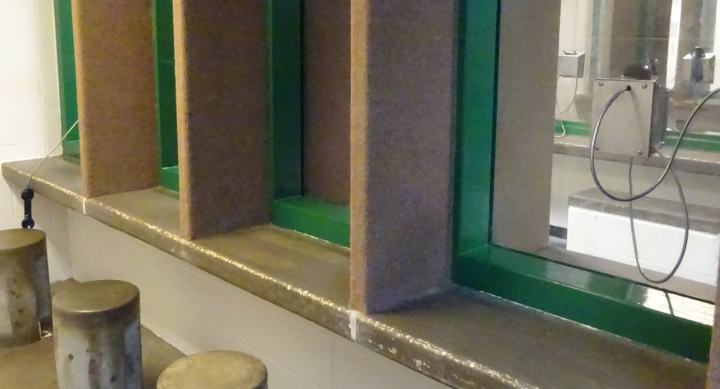What if every conversation you had with your brother put him in danger of being placed in solitary confinement? This is the reality for everyone with an incarcerated loved one. What should be routine family conversations carry much higher stakes for people in custody—stakes that have only increased with the advent of new technology.
The COVID-19 pandemic introduced new policies into U.S. correctional facilities that were intended to mitigate the spread of the deadly virus, but also had the effect of further restricting and isolating incarcerated people. Not least among them is the expansion of prison communication surveillance: the increasing monitoring of prison and jail phone calls and mail. The urgent need for corrections officials to quickly respond to COVID within their facilities presented a unique, profitable opportunity for vendors with experimental technologies purportedly capable of flagging symptoms where the human eye or ear could not. Though these tools may offer health and safety benefits, they also can produce grave consequences that go beyond facility walls and that will surely outlive the presence of the coronavirus.
To be flagged is to risk being targeted, misinterpreted, and even punished.
Communication surveillance tools provide corrections officials with easier and faster means of mass monitoring. One way these tools are used is to automate the monitoring and analysis of phone and video calls and other communications between people in custody and the outside world. During the COVID pandemic, prison agencies began using surveillance tools to identify incarcerated people that may have had symptoms of the deadly virus. Staff could use the technology to more quickly identify people in custody with symptoms, and direct them to the appropriate public health intervention (e.g. testing, isolation, quarantine, etc.). For example, one of the leading vendors for prison communication surveillance identified and flagged thousands of calls mentioning “cough” or “sneezing” in just the first month of the pandemic. It would have taken an agency employee much longer to manually transcribe that many phone calls, and as prison agencies argue, the virus could have spread throughout the facility that much longer before staff would have been able to properly quarantine infected individuals.
While officials cite concerns over incarcerated people’s well-being as motivation for pursuing communication surveillance contracts, agencies have used these tools to advance their security interests, often with little regard for the detrimental impact they can have on people who are incarcerated and their loved ones. When a call is flagged, an individual’s name and conversation transcript is shared with agency officials, who may decide to act on this information however they see fit. In one prison, authorities reported scanning calls for “potential ammunition to fight lawsuits.” In another instance, a person in jail was flagged by staff after talking to his father over the phone about contacting the media to discuss the ways the corrections agency was covering up a COVID outbreak. An official report about his call was shared with nearly a dozen prison staff members as well as employees of the surveillance vendor. It is unknown how the report affected the incarcerated person, but it’s no secret that people in custody who raise concerns about conditions regularly risk retaliation by facility officials. Surveillance tools make it easier for facility staff to identify people who complain and retaliate against them using various forms of punishment or intimidation.
Compounding this problem is a lack of oversight of an agency’s use of surveillance tools. No one is tracking the technology’s error rate, for example, or the data mining techniques agencies are using, or the overall design of the surveillance system, all of which can pose serious concerns around bias and accuracy, concerns that have yet to be addressed by vendors or corrections agencies. Individuals in custody are thus “targeted based on little understood, potentially biased, and even abusive algorithms.”
The right to privacy vanishes within the confines of a prison, but its absence is certainly felt by those of us on the outside as well.
What happens when a flippant comment or venting session carries the very real threat of putting your loved one in harm’s way? This is a fear that I– and nearly half of Americans who have a close relative in custody–experience on a constant basis. Even from the safety of my bedroom across the country from my incarcerated sibling’s prison, I feel the stifling presence of a watchful “other.” Knowing that a prison employee is listening to our phone call in real time or that our conversation will be archived for future monitoring leads to watered down conversations often punctuated by long pauses, vague responses, and an overarching sense of anxiety. Our heightened awareness stirs emotions unique to the prison communication experience–I feel angry having to always censor my comments, and remorseful after asking the wrong question and being met with silence. I feel helpless when I’m confused about a story, but I don’t ask for clarity because even a small detail can risk flagging the call and putting my brother under extra scrutiny.
My brother and I have never been able to have a normal conversation without the fear of severe consequences. Even before he began masking his COVID symptoms from me–in fear of being sent to a quarantine building with no running water or working phones–my brother would downplay reasons for being sent to the hole. As he has always said over the years he’s spent in prison, “it is a feat to avoid being taken to the hole.” The right to privacy vanishes within the confines of a prison, but its absence is certainly felt by those of us on the outside as well.
The pandemic supports the argument for increased, uninhibited surveillance, paving the way for a steeper slope into mass monitored environments inside prisons and out.
To be clear, the surveillance of prison and jail communication was common practice before COVID entered correctional facilities. Physical mail has always been inspected and phone calls have always been recorded. Years before the pandemic, dozens of facilities across the country began banning physical mail to combat contraband, relying instead on mail that is electronically scanned into a database full of sensitive information that any designated agency or vendor employee may access. Corrections agencies store intimate, personal conversations for an indefinite period of time and can read them any time. This is why my fear of retaliation against my brother never goes away, even after our conversations end.
But corrections agencies used COVID as justification for increasing their use of surveillance tools inside prisons and out. Agencies with some of the largest prison systems across the country such as California, Texas, Oklahoma, Louisiana, Georgia, and New York entered new contracts with surveillance technology companies during the pandemic.
Indeed, the technology holds great promise for people who are incarcerated–it provides people who are incarcerated with a means of maintaining communication with the outside world, and accessing programs and services when agencies are otherwise unable to provide them. For example, more prison agencies are allowing people who are incarcerated to use tablets to communicate with their family and loved ones when visitation is suspended. But without regulation, the privacy and censorship concerns warrant serious pause. Should vendors that supply tablets to prisons and jails really be allowed to require users to give up ownership over their own words and images? Do video visits really need to be downloadable and searchable for an indefinite period of time? How can agencies maintain security of facilities while also respecting family members’ and loved ones’ right to privacy?
For now, what corrections officials decide to do with the information they gather from communication surveillance is entirely out of our control, and we’ve already observed material harms resulting from the practice. But as companies continue to roll out novel technology, corrections agencies and legislators have a lot of work to do to protect the privacy of people who are incarcerated and their loved ones.
"Degree of Civilization” is the blog of the Prison and Jail Innovation Lab, its title adapted from Dostoyevsky’s famous quote, "The degree of civilization in a society can be judged by entering its prisons.” Our blog posts will explore and analyze the dehumanizing and dangerous conditions in our nation’s prisons and jails and the critical need for effective independent oversight and meaningful data about what’s happening behind the walls. We’ll be commenting on recent news and developments; analyzing data that highlights trends that affect the safety and health of the people who live and work in correctional facilities; and reflecting on the lived experiences of people who are incarcerated. The entire PJIL team will be contributing to the blog, so you are sure to hear different voices and approaches to these issues.
Author
-

Destiny Moreno
Destiny received her MPAff from the LBJ School in 2022 and her Bachelor of Arts in Public Policy with a minor in Science, Technology & Society from the University of California at San Diego in 2020. Outside of PJIL, She worked as a researcher for the Good Systems UT Grand Challenge on a project leveraging AI to improve the lives of people experiencing homelessness, and investigated the use AI-enabled surveillance in Texas as a Brumley Fellow under the Strauss Center’s Artificial Intelligence Studies program.
At PJIL, Destiny primarily worked with data collection and analysis, as well as website design and development. She is a co-author on PJIL publications "COVID and Corrections: A Profile of COVID Deaths in Custody in Texas" and "Dead Man Waiting: A brief profile of deaths in Texas prisons among people approved for parole release." Destiny is currently a JD Candidate at the University of Washington School of Law.
Key Words
covid
mass monitoring
prison communication
surveillance


